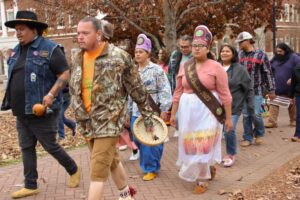
Originally published in The Western Carolina Journalist
November is Native American Heritage Month, but it’s not just a heritage for the Cherokee people of Western North Carolina. It’s a living, vibrant culture.
There are 547 federally recognized tribes in the United States. Native Americans were not automatically afforded U.S. citizenship until 1924. November was not declared Native American Heritage Month until 1990. It is estimated that there were as many as 15 million indigenous people in the U.S. in 1492. By the end of the nineteenth century, there were less than 238,000.
Despite genocide, stolen lands, death marches, and forced assimilation through boarding schools, Indigenous Americans refused to let their culture be lost. Cherokee people, who originally called themselves Aniyvwiya or, “the principal people,” have resided in the mountains of North Carolina as far back as 11,000 years ago. The story of the Cherokee people is not one of defeat, but of resilience and perseverance.
Rainy Brake, who teaches Cherokee language at Western Carolina University, commented that while the Cherokee people have suffered tragedy in their past, that is only a very small part of Cherokee’s identity.
“A lot of us are taught Trail of Tears, terrible story, really sad, really awful…and I hate that perspective. It’s a story of resilience and integrity, and survivorship, and going to the Supreme Court and fighting diplomatically, and resisting violence. I wish people would see that more during Heritage Month. I think that people need to tell the story from a Cherokee perspective, and a Cherokee perspective on their own story is not a ‘woe is me’ story. It’s a story about looking forward and making things better continuously,” Brake said.
Brake obtained a Cherokee Language graduate certificate and became the first certified teacher at the New Kituwah Academy Immersion Program in 2009. She taught at the academy from 2009 to 2019, then began teaching Cherokee language courses at WCU in 2019.
Native American Heritage Month is about recognizing the many contributions that indigenous people have made to the U.S. It doesn’t undo the many wrongs done, but many who we spoke to think it’s an important start.
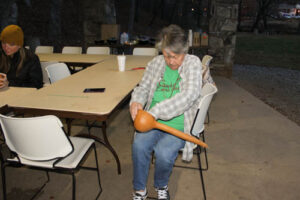
Louise “Yogsi” Brown is a fluent Cherokee speaker and member of the Eastern Band of Cherokee Indians, and began teaching Cherokee language classes alongside Rainy Brake at WCU in 2019. The two have been long time partners in the language revitalization initiatives, working together since Brake began teaching at Kituwah. Cherokee is an endangered language, with only about 2,000 of the 380,000 Cherokee Nation of Oklahoma members and 152 of the 16,800 EBCI members speaking Cherokee fluently. Yogsi is one of the few remaining whose first language was Cherokee.
“I think Native American Heritage Month and Western Carolina go hand in hand, because it is our homeland. It is who we are, and we are still here. When I walk with my skins on, and I walk on that earth, I am so proud,” Yogsi said.
The land where Western Carolina University now sits was once known as Tali Tsisgwayahi, or Two Sparrows Town. It was the first Cherokee town in the Tuckasegee River Valley. This name had been lost for many years.
In 2015, WCU’s Sequoyah Distinguished Professor Brett Riggs and Tom Belt began a project going through the collections of ethnographer James Mooney. Mooney studied the Cherokee people and kept extensive records in the form of maps, fieldnotes, letters, and interviews. Riggs rediscovered the name in a letter from Assistant Chief Charles Hicks to John Ross. Riggs knew it was essential that the name was not lost again. With the approval of EBCI Tribal Council, he saw to it that WCU’s archeological curation facility was named for the town. On Dec 6, 2019, the facility located on the ground floor of the McKee Building was dedicated as the Two Sparrows Town Archeological Collections Curation Facility.
“What that did was put that name on campus permanently, so it won’t be forgotten. I would love to get it on the entry to the university,” said Riggs.
He said that the last Cherokee families to live on the land where WCU now sits were forced off the land in 1820’s.
“Like what happened on almost all these reserves, they were pushed out by whites who came and took over the land,” Riggs said.
While the university’s relationship to the Cherokee heritage of the land has not always been so diligent, Riggs said the university has taken an initiative to incorporate more Cherokee elements around campus. This would include signage on Cherokee history and culture, QR codes that would allow people to hear Cherokee language, using the rooftop terrace on Apodaca to examine the Cherokee astronomy of WCU’s location, providing more accessible material on current indigenous relations, and installations by Cherokee students about their experiences.
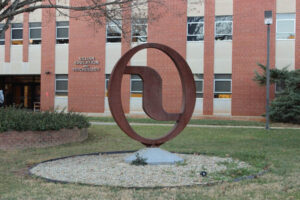
“My goal is to make this a much more Cherokee place. There’s all these different ways that Western can embrace the Cherokee heritage of this place, but also reinforce the idea that it remains a Cherokee place. Richie Sneed (28th principal chief of EBCI) when they did the dedication for the Wi statue, his speech he gave was crafted. What he said is, ‘We are happy to be here, and we are happy that we can share our place with you,’” Riggs said. For full disclosure, one of the reporters for this story is Sneed’s daughter.
Many efforts are being made to recognize and preserve the inherent Cherokee identity of WCU.
Digali’i, WCU’s Native American student organization has more than 10 tribes represented in their ranks. Seth Penn is a student at WCU since August 2022, and chairman of Digali’i since August 2023. He is a member of the Cherokee Tribe of Northeast Alabama, which is a state recognized tribe. Penn is double majoring in natural resource conservation and management and anthropology with a cultural concentration. He is also minoring in Cherokee studies. He chose WCU because of the Cherokee culture and language resources available at the university. He was impressed with the university’s efforts to have a relationship with the tribe that originally inhabited the land.
“To me, it’s an amazing opportunity to acknowledge and honor our past while embracing the future through pursuing a college education that I will use to help indigenous people across this state, back home, and beyond,” he said.
Penn said Digali’i is all about promoting an environment that’s inclusive, diverse, and respecting of all indigenous people. He said Digali’i also recognizes and honors the non-indigenous allies to the community. Penn specifically mentioned the invaluable contributions from faculty in the linguistics and anthropology department, including Dr. Riggs, Dr. Eastman, Dr. Hopkins, Dr. Steere and Rainy Brake. However, he thinks there is room for improvement in university relations with indigenous students.
“There is some racism on campus that is very much alive and well. I’ve had derogatory remarks made to me and heard of them made to other people as well. I almost feel like what is done for us is almost token like. I would like to see a more genuine approach and more relationship building. I’m proud of what we have done, and I’m proud that they [WCU] acknowledge what they do acknowledge, but there’s always room for improvement. I hope while I’m chairman of Digali’i I can do everything in my power to help make those improvements; not just point out those problems but be part of the solutions as well.”
Penn said the university could improve its relationship with its Cherokee identity by changing the tone around the discussion of Cherokee people on campus from past tense to present tense. He said people tend to think of Cherokees as existing here in the past, but there are many indigenous people who are part of the Catamount community today. He would like to see the stories of those who are still here better represented.
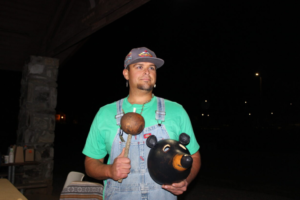
“We’re still here. We remain. Our languages are still here, our stories are still here. While our ancestors may no longer be here, they very much live on in our hearts, and we honor them every day. I’d like nonindigenous people to understand that yes, there’s a rich history, but that history is still alive, it’s not dead,” Penn said.
Throughout Native American Heritage Month, the university hosted several events to showcase Cherokee Culture.
On Nov. 14, Jimmy Harlan and Elias Husky hosted a Cherokee Gourd workshop on campus. Harlan, who instructed the workshop, is a mask maker by trade and cultural specialist with the EBCI. He has been working with gourds for 26 years. He said that gourds have been used to make utilitarian items such as dippers and water bottles, as well as more culturally significant items like masks and rattles. Harlan is knowledgeable in many Cherokee crafts such as basket making, woodcarving, and flint knapping.
“I want to do things that preserve what I do, preserve the heritage in my blood,” Harlan said. He went on to say that being Cherokee comes with a responsibility to carry on traditions, and that there is a big difference between claiming indigenous heritage and living the culture.
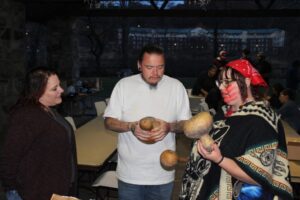
At the center of campus on Nov. 15 a group of 20 students, faculty, community members and WCU staff gathered to participate in the Rock Your Mocs Walk that was planned as part of WCU’s celebration of national Native American Heritage Month. They surrounded the fountain area, some wearing traditional regalia, ribbon skirts, and various styles of moccasins. The group was led by Jimmy Harlan and Jarrett Wildcatt, both members of the EBCI. The group walked from the fountain down to the H.F Robinson Administration Building and back. Harlan, with his beaded moccasins and feathers in his hair, guided the group while beating a drum. Wildcatt, sporting Cherokee pucker-toe moccasins, shook a rattle and sang traditional songs in Cherokee. The event demonstrated the living indigenous culture on WCU’s campus.
Among the events was an exhibit in the mountain heritage center “A Century of Cherokee Mask Making”. It is on display from Nov. 10 to March 1, 2024. This exhibit shows the role masks have played in the effort to keep Native American culture alive. The Cherokee wore masks during ceremonies and dances. They would use
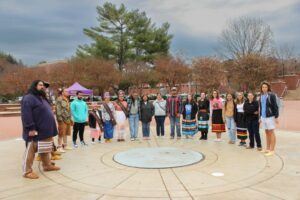
natural materials and various tools to craft the mask. To add color, they used natural dyes. These worked together to create lively representations of animals or humans. Mask making was almost lost in the early 20th century. But with the Native American rights movement, there was a renaissance of indigenous culture. By the 1970s Cherokee artists were able to bring back the tradition of mask making for future generations. To celebrate the exhibit there was a reception on Nov. 16 with Davy Arch, an artist with nearly 50 years of Cherokee mask carving experience. Arch was able to do a mask craving demonstration to showcase some of the artistry passed down through generations. Each Mask tells its own story. These works of art keep the Cherokee culture alive and present.
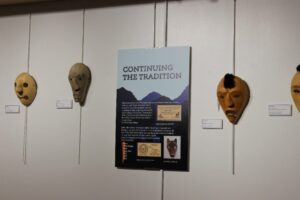
Cherokee people have fought to keep their culture alive despite many obstacles. The need for cultural revitalization is part of WCU’s past, present and future. The university has a responsibility to help Cherokee culture thrive on its campus. During Native American Heritage Month, WCU demonstrated their commitment to maintaining a positive relationship with EBCI by hosting events, ceremonies, and exhibits that showcased the rich Cherokee culture. History cannot be rewritten, but it can be learned from. Without the use of the Cherokee’s land, WCU would not be here. The phrase that was repeated among the Cherokee people that we interviewed perfectly captured the theme of Native American Heritage Month – “We are still here.”






